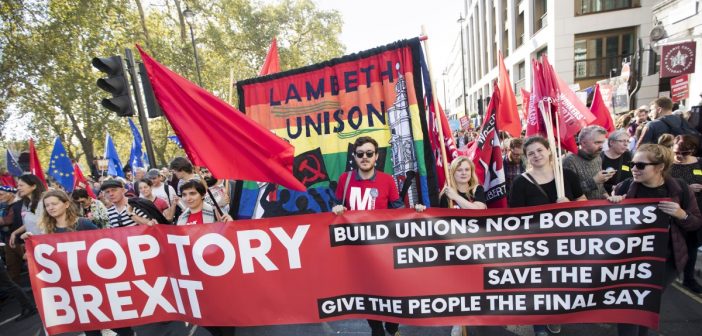Phil Hearse writes: Jon Cruddas’s new Guardian article has a simple message, widely backed by left-wing Brexiteers, that Labour will lose its traditional working class base if it backs a ‘Remain’ position on Brexit. Moreover, he argues, there is a growing false position that wants Labour to stop being a party based on the traditional working class, and move towards a less class specific urban base in ‘Remainia’ – the clear implication being that this is a capitulation to middle class interests and values. Cruddas takes as a key example of this false position articles by Paul Mason. He says:
“…recently both the social-democratic and radical left have sought to assert a new progressive ‘base’. A leading advocate of this historic rethink, Paul Mason, recently suggested that ‘a new strategy must be based on the realisation that Labour’s heartland is now in the big cities, among the salariat and among the globally oriented, educated part of the workforce’. He identifies this as the ‘new core of the Labour project’, a distance away from the classical left proletariat. The new ‘base’ is to be formed around ‘networked individuals’ residing in ‘Remainia’.”
We come back to some of Paul Mason’s more florid language later, but let’s look here at the Cruddas counter-argument. He maintains that Labour can only win by being firmly based on its traditional (and pro-Brexit) working-class support, which is one that cleaves to old-fashioned ideas, like the importance of work – unlike all those people in social classes ABC1, where Labour had a big lead in 2017.
In the Cruddas account, there is no clear explanation of what the working class actually is today and its social and occupational diversity. His article reads as if his concept of the working class is that it is a mainly white social grouping working in factories, mines, steel mills and on the railways. This flies in the face of all known facts about the social and occupational diversity of the working class today.
The argument has been put abouti by left Brexiteers that the Liberal Democrat majority in Jeremy Corbyn’s Islington North, in the Euro elections, was a middle-class vote, because ABC1 voters are the majority there.
But these are not Marxist class categories, but marketing target groups. As it happens C1 includes most clerical workers and a big majority of non-manual workers. So, for example medical secretaries, school administrators, low-paid civil servants, library workers, armies of low-paid local government workers, teachers and many others are in C1 and are in the main working class; and this group probably has a majority of women and millions of ethnic minority people. This is the reality of much of the working class in urban centres today. They are not trendy infotech start-up owners linked to globalised networks and earning £100,000 a year. Far from it, many of them are very low paid, even if many of them have university degrees. And they are precisely the working-class group which together with students delivered huge votes for Corbyn and Labour in the 2017 election.
There is one glaring omission from Jon Cruddas’s article that will surely strike anyone, irrespective of their position on Brexit. There is no discussion whatever of the social and political content of Brexit, and no mention for example of English nationalism, xenophobia, anti-immigrant prejudice or the growing racism that has mushroomed after the 2016 referendum. There is no mention of the fact that Brexit is, and has been for more than two decades, a project of the hard right of the Tory party, one which they have successfully used to seize control of that party.
Jon Cruddas says, well of course we can’t be all about wining elections and ‘triangulation’, we have to stick to our core principles and values. Thus:
“In any case, political parties do not just exist to chase votes. They are traditions built around competing theories of justice and democracy; alternative approaches regarding how society should be organised. For Labour, the Brexit dilemma goes to a tension at the heart of the party regarding its character and purpose; even existence.”
All very well, but surely the core traditions of justice and democracy include the fight against racism and in favour of multiculturalism; opposition to xenophobic nationalism; and support for the rights of immigrants and migrant workers? The issues of racism and immigration are not touched on in the Cruddas article. This is indeed a symptomatic silence, a deafening one. And in any case why should a commitment to social justice imply opposing Remain?
Cruddas talks about a Labour working class base without reference to the fact that, as Wayne Asher explains:
“The generally accepted idea that working-class areas voted massively for Leave is only partially correct; many did, but traditional working-class areas in London delivered the highest Remain votes (peaking at 75 percent in Haringey and 78 percent in Hackney and Lambeth). Remain won in most of the great working-class regional capitals (Bristol, Cardiff, Leicester, Liverpool, Manchester, Leeds, Newcastle-upon-Tyne.) Only three cities of similar importance voted Leave and even then they did so by tiny margins (Birmingham, Sheffield, Nottingham). Working class Scotland voted massively for Remain of course.”ii
In addition:
“Two out of three Labour voters voted Remain. (I suppose that voting Labour rather than Tory counts as the minimum entry level of class consciousness.) A majority of those in work voted Remain, irrespective of whether they were in part-time or full-time work. Two-thirds (67 percent) of those describing themselves as Asian voted Remain. Four out of five black voters (73 percent) voted Remain, and 70 percent of Muslim voters did so too. These voters obviously understand the real dog-whistle message during the referendum campaign.”
This is not to deny that millions of workers did in fact vote Leave, or that many of them would back a hard Brexit. But it puts in perspective the idea of real workers backing Leave and the globalised urban petty bourgeoisie voting Remain.
There is something else that is equally disturbing. Trying to draw a class line between the working class Leavers and the globalised Remainer elite – as not only Cruddas but some other left-wing Brexiteers do – is a caricature that has nasty echoes of what UKIP and the Brexit Party argue (not to mention the Daily Mail). It’s the globalists, the elites, that want Remain.
Jon Cruddas says that it’s true that in the Euro elections Labour lost more voters to the Liberal Democrats and the Greens than to pro-Brexit parties, but looked at over time Labour is losing more voters in Leave-type areas – presumably he has in mind places like South Wales, some south Yorkshire towns and his own constituency of Dagenham, which in recent times has elected BNP councillors.
Long-term decline in Labour support in these places has a lot to do with the collapse of traditional industries and the defeats suffered and subsequent decline of the labour movement as a whole. Left-wingers are quite right to be angry at the failure of successive governments, and in particular the 1997-2010 Labour government, to take the radical action needed to rescue these areas from penury and social misery. This failure indeed opened the door for political reaction.
The attitude that ‘none of them care about us’ is widespread in the ‘left behind’ areas and has been mercilessly used by the extreme right. But how? Not just in the assertion that both left-wing and right-wing elites don’t care about the working class, but also that the poverty and destitution of these areas is the direct result of immigration and the prioritisation of aid to immigrant areas over ‘our people’ (the same argument is made about foreign aid). Talk to pro-Leave people in left-behind towns and check out how many of them agree with the formulation ‘there are too many immigrants over here’. A very high percentage. Ask the self-same people about their attitude to Donald Trump or hanging. It is surely an elementary procedure to separate why people adopt a political position and the social content of that position. Votes for Donald Trump in the Mid-West rust belt were surely in many cases a function of distrust and hatred of the neoliberal elite that Hilary Clinton embodied. But it was still an utterly reactionary vote. And those many middle class and some working class people who voted for the Brexit Party in the Euro elections, also cast a reactionary vote.
Long-term decline in Labour voting in some poorer areas pre-dates the Brexit referendum. It is a major problem, of course; and it’s true that it poses some difficult tactical choices for the Labour leadership.
But prevaricating is going to get nowhere. In the Euro elections many canvassers reported that Remainers thought Labour was for Leave, and Leavers thought it was for Remain. Labour has to shore up its base among socially progressive voters who opted for the Liberal Democrats and Greens this time. The Corbyn leadership must repeatedly point out the LibDem responsibility for austerity, and that the only way to get the Green Party’s pro-environment policies implemented is to vote Labour.
Actually the question of a second referendum is not the central one. The key is No Tory Brexit! Effectively this resolves itself into No Hard Brexit! And then logic of that is crystal clear. Better Remain than a Hard Brexit.
And that is the question that will separate out the true xenophobic core. There’s absolutely no point in being diplomatic here. We are absolutely saying that racism is widespread in some sections of the working class: the point is to fight it.
Paul Mason uses some flowery and speculative language about the newer working class in the big urban centres. But the rational core of Mason’s speculations can be simply extracted. The new working class is younger, more female and more ethnically diverse. Most of them voted Remain not because they love the institutions of the EU, but because they are pro-multiculturalism, pro-feminist, internationalist-minded and because they hate Nigel Farage and everything he stands for. They are also the base of the growing movement for climate justice. It is by fighting for these values that the base of Labour and the Left can be extended outwards.
iFor example, in Bury Momentum

